11 Incredibly Powerful Ways To Nurture Inclusion At The Workplace
I like to think about inclusion at the workplace as being similar to humility.
Everyone wants to admit they have it, but in reality, they don't.
In a recent Deloitte survey, 80% of employees consider inclusion an essential factor in choosing an employer.
But what does having an inclusive workplace culture truly mean? Is it the same as having a diverse workforce?
Let's take a look.
There Is No Diversity Without Inclusion
Imagine hosting a dinner party.
Every guest has their own set of preferences. Some are vegetarian, while others are vegans. Some have a gluten allergy; others don’t like eggs.
The problem is, you have a set menu. Even unknowingly, you have managed to alienate half of your guests.
Seeing that problem, you made a few changes the next time you hosted a dinner. And the following week. And the week after that. Until finally, you create a menu that every guest manages to enjoy.
Diversity is getting a dinner invitation. Inclusion is making sure everyone enjoys the meal.
Creating an inclusive workplace culture is very different from simply creating a diverse company culture.
A diverse workforce means having a headcount of various gender, races, and sexual orientations only because it looks good on the company's brochure.
On the other hand, an inclusive company culture separates itself from any possible unconscious bias in the work environment. Employees feel included irrespective of who they are or as what they identify themselves as.
Recommended Article: A Definitive Guide on Diversity and Inclusion in the Workplace
11 Actionable Steps To Improve Inclusion At The Workplace
The significant challenge for inclusion is to build a company culture where everyone feels included.
You go through significant troubles to bring in diverse talents to your organization. So why not ensure that their employee experience is more than stellar.
Here are 11 remarkable ways to build an inclusion strategy that actually works.
1. Educate Managers About Inclusion At The Workplace
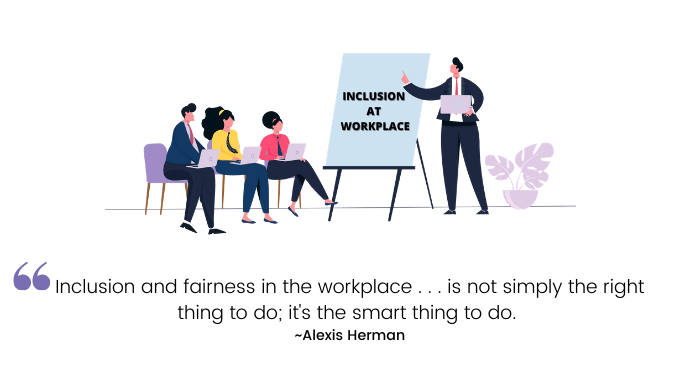
An organization’s managers are monumental in promoting an inclusive workplace culture.
A manager is most often on the frontline and acts as the bridge between employees and the management. Thus it matters a lot that they know how to handle a diverse workforce.
But here’s the thing. Mishaps happen. That is why managers need to be educated and trained to understand and support all employees and cultivate an inclusive culture.
Recently, Starbucks was plagued by an unseen act of racism that shook the company to its core.
In response, the coffee chain held a mandatory unconscious bias training attended by roughly 175,000 Starbucks employees. Additionally, it closed almost 8,000 of its stores until the diversity training was completed.
While you don’t need to go to such drastic measures to educate your staff about diversity and inclusion (D&I) in the work environment, here are some tips that will help:
- Scheduling cultural training, diversity workshops, and seeking to end unconscious bias by educating employees on the importance of everyone’s inclusion.
- Conduct a comprehensive evaluation of the workplace. Look at how inclusive the work environment is. Are there non-gendered washrooms? Are people excluded from projects because they have a different sexual orientation? Do people make thinly veiled comments about gender, race?
- Having an employee feedback system and its relevant assessment. Unless you give employees a voice of their own, you’ll never really know what went wrong.
2. Creating Inclusive Workplace Culture Through Rethinking Workforce Policies

Building an inclusive culture means that you may need to create new policies or abolish some previous ones entirely. These policies may range from recruitment to performance management.
Here are some ways to model your company policies for a more diverse workforce:
- Facilitate the hiring process to include candidates from various community outreach programs, job fairs, and hiring consultancies. That ensures that you have a variety of diverse talents.
- Women still make only $0.79 for every dollar men make in 2019. Make sure that your company pays employees based on their skills and job title. Gender, race, and sexual orientation should not be a part of getting paid less than you deserve.
- Different cultures, different holidays. Make sure your employees get leaves for holidays that are not covered in the official company holiday calendar.
3. Communicate Inclusion Goals And Measure Progress

Simply creating inclusive workplace policies isn’t enough. It’s more important to communicate your expectations to your workforce.
Employees should feel that they can talk to their managers in case they face discrimination of any kind.
In turn, managers should keep their minds open by avoiding any assumptions and making sure that employees feel free to share.
Here are a few ways through which you can create an open communication channel for inclusion concerns:
- Regularly ask for feedback about the employee experience in your organization.
- To ensure that inclusion goals are met, create dedicated diversity panels. Having a diverse panel of members ranging across various departments ensures that the process remains transparent for everyone.
- Not everyone is comfortable speaking up against ongoing discrimination in the workplace. The diversity panel should assist with ongoing efforts to make the work environment free of any unconscious bias.
4. Celebrate Differences To Make Everyone Feel Included

Encourage your workers to practice their culture and traditions within your company as one of the best ways to demonstrate that you respect them.
Here are some ways through which you can promote inclusiveness at your workplace:
- Potluck lunches where people bring in food that showcases their culture.
- Recognize and celebrate days with significance to other communities, such as Black History Month in February, or Juneteenth and Pride Month in June.
- Ensure that employees of various races, cultures, and ethnicities have a say in your organization's decision-making process.
- Every employee carries with themselves the stigma of belonging from a community that faced some kind of discrimination. Make their stories known through an organizational publication to voice their opinions, ideas, beliefs, and any experience of prejudice in the organization.
5. Diverse Opportunities For Employee Engagement

Creating an inclusive workplace culture for a better employee experience has become necessary and not just an option.
- If your company has diverse locations, allow employees to visit those locations and experience the work culture around it. That will enable employees to have a first-hand opportunity to see how diverse cultures have a different way of doing things.
- Conduct an employee pulse survey and judge what experiences your employee would want to appreciate the benefits of diversity.
- Assign a diversity mentor from a different community so that the mentee has a better chance to get inspired and look up to someone who would show that talent is what matters despite the differences.
6. Early Introduction To Inclusion (At Onboarding!)
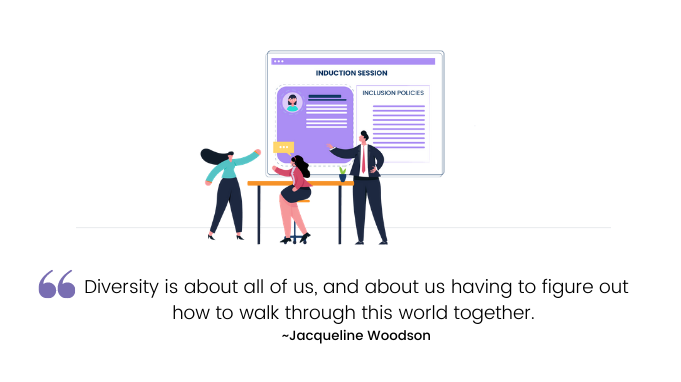
To build an inclusion-based culture, it’s essential to start at the very beginning.
Preach, advocate, and promote that inclusion is an integral part of your company values. Forward it to your social media channels, websites, or interviews so that any future employee (or the general mass) is aware of your inclusion goals and your commitment towards making diverse employees feel included.
Establish the importance of inclusion and diversity in the workplace during the onboarding of a new employee.
- Ensure that every new hire is made aware that your company is a safe place for every gender, race, culture, or disability.
- Update new hires about the current D&I policies and what measures to take if they face any discrimination on their part.
- Additionally, promote how any workplace discrimination will not be tolerated and met with strict actions.
- Take an onboarding survey to find how you could improve your D&I-focused hiring and orientation process.
7. Make Pronouns Matter
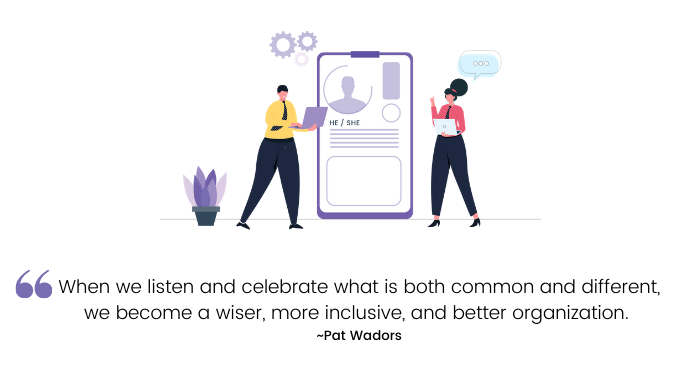
Inclusion at the workplace is meaningless when people are not respected for who they identify as.
The pronouns that a person might prefer are their own choice.
It is about who they actually are. Mistaking an employee's pronouns might be a great source of stress and can induce an identity crisis for that person. Thus, to make your company "pronoun-friendly," follow the below steps:
- On the employees' identification cards, offer a section on the pronouns that employees prefer.
- Advocate for the significance of asking for other employees’ preferred pronouns during initial interactions.
- Any job description or posting should use gender-neutral language. Amazingly, there’s a Gender Decoder app that decodes whether your job ads have any unconscious bias attached to them.
- To facilitate using the right pronouns in team communications, consider using tools like Alex. Alex helps you and your employees determine if they are unconsciously insensitive to their peers during team communication.
8. Diversity And Inclusion (D&I) Communication Channel
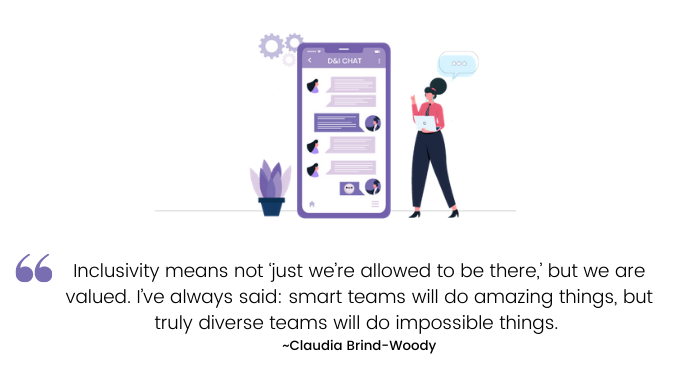
Your company culture shouldn’t just practice inclusion. It should encourage open conversations too.
Leverage the tools you already have, such as Slack and Microsoft Teams, to share articles, news, and support for your diverse workforce.
Additionally, conduct diversity and inclusion seminars where leaders or advocates are invited to enlighten your workforce.
Furthermore, you can host volunteering opportunities for employees who seek to help out communities that face the brunt of discrimination daily.
It's important to advocate for constant education of the blatant or unconscious bias minorities face and how your organization can be sensitive to their needs and rights.
9. Form A Diversity And Inclusion (D&I) Committee
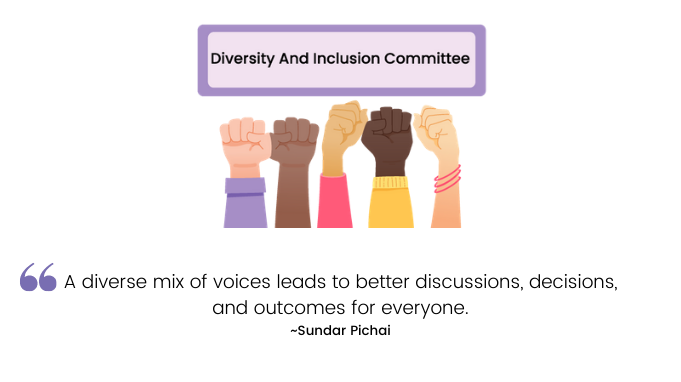
A diversity and inclusion (D&I) committee is a necessary measure that every inclusive organization should adopt.
A D&I committee would act on your behalf to promote, support, and drive the necessity of inclusion at the workplace. Most importantly, such committees help keep a check on if the inclusion strategies are being followed and useful.
Also, D&I committees serve as the bridge between you and your employees. The members of the D&I committee are employees themselves.
Thus, it becomes easier for them to recognize and empathize with any unconscious bias occurring. These committees seem more approachable to employees than going up to a manager and placing any complaints.
10. “Round Robin” Meetings
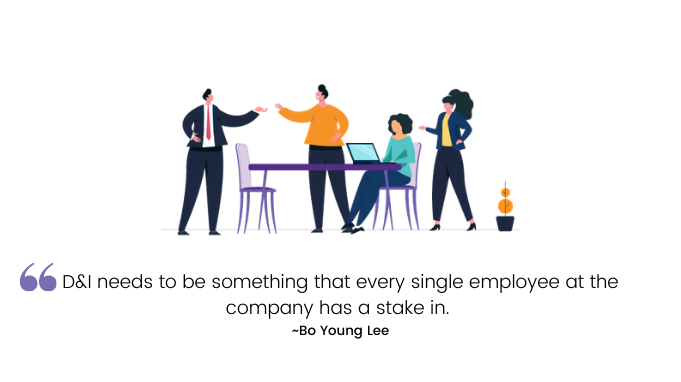
Meetings are a great way to gauge whether your workplace is actually as inclusive as you think.
Are your male employees more likely to offer their opinions? Do some employees frequently cut off others while they are talking? Do your diverse employees hesitant to speak up and present their ideas?
If the answer is "yes" to the above questions, likely, your diverse workforce has not been given the right opportunities to grow professionally.
A good starting point is to make the meetings honor everyone’s ideas through the “round-robin method.” The round-robin method is a technique where every person in a meeting is given equal opportunities to speak, share, or demonstrate without anyone else cutting in. That ensures an equal and level playing field for every employee to participate and discuss.
11. Tie D&I Efforts To Everyday Conversations

The last but the most crucial step is to make sure that workplace inclusion becomes a part of your everyday work-life culture.
A powerful way to encourage employees to learn how to be more sensitive and welcoming towards every other employee is to reward and recognize good behaviors.
Thus, if you see an employee going out of the way to respect their diversely different peers’ customs and needs, be sure to publicly appreciate their efforts.
Although being transparent and nonjudgmental is the bare minimum, recognizing specific practices helps establishes a standard that you value individuals who treat others with dignity.
Recommended Article: The Ultimate Guide To Employee Rewards and Recognition
The Story’s Not Over
Diversity in an organization leads to better teams, greater innovation, and more efficient decision-making. But inclusion is what connects people to the organization and makes them want to stay.
Do you have any other innovative ways to make inclusion an integral part of your diverse workforce? Please drop us a mail and share your thoughts with us!


















